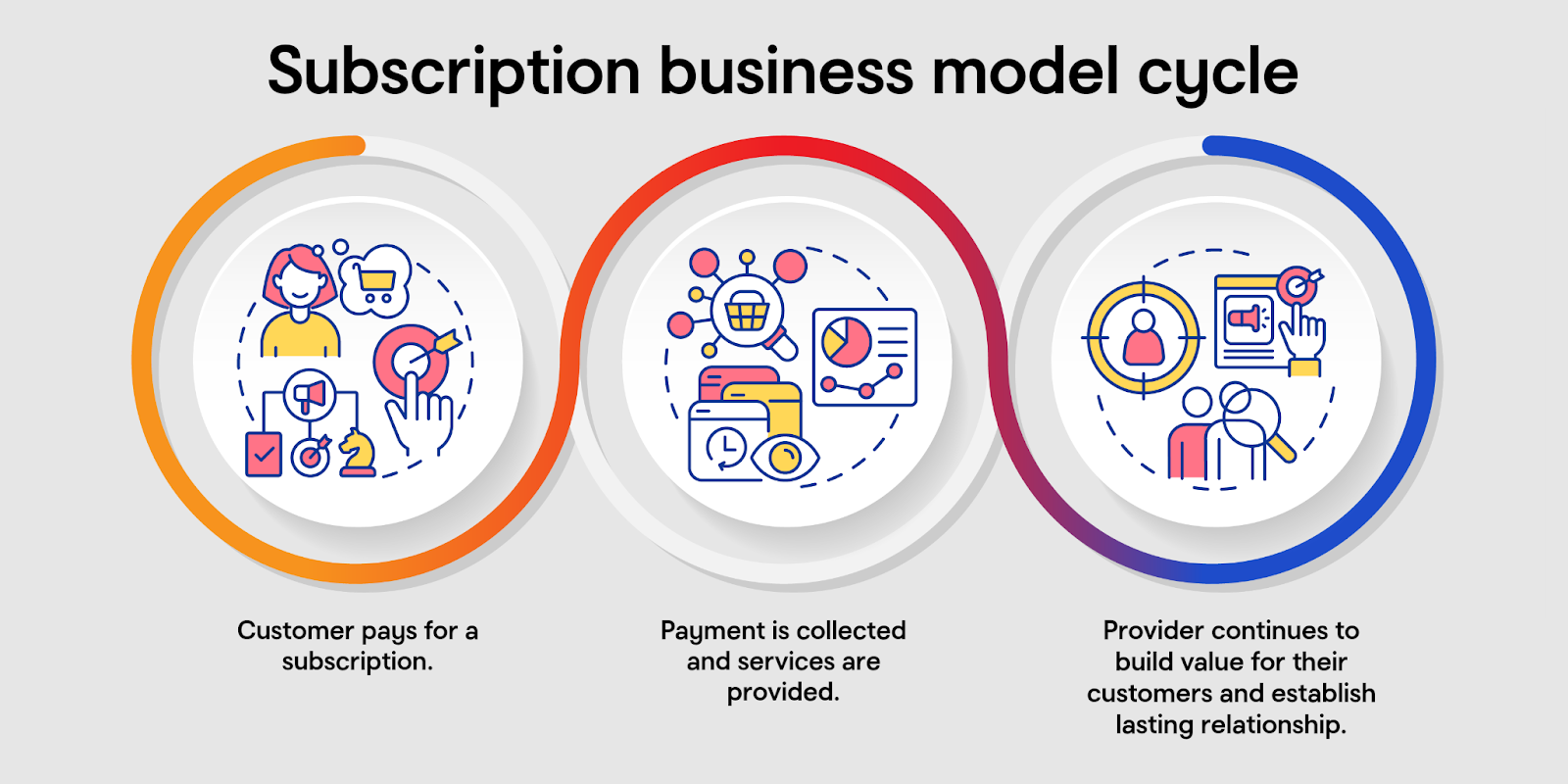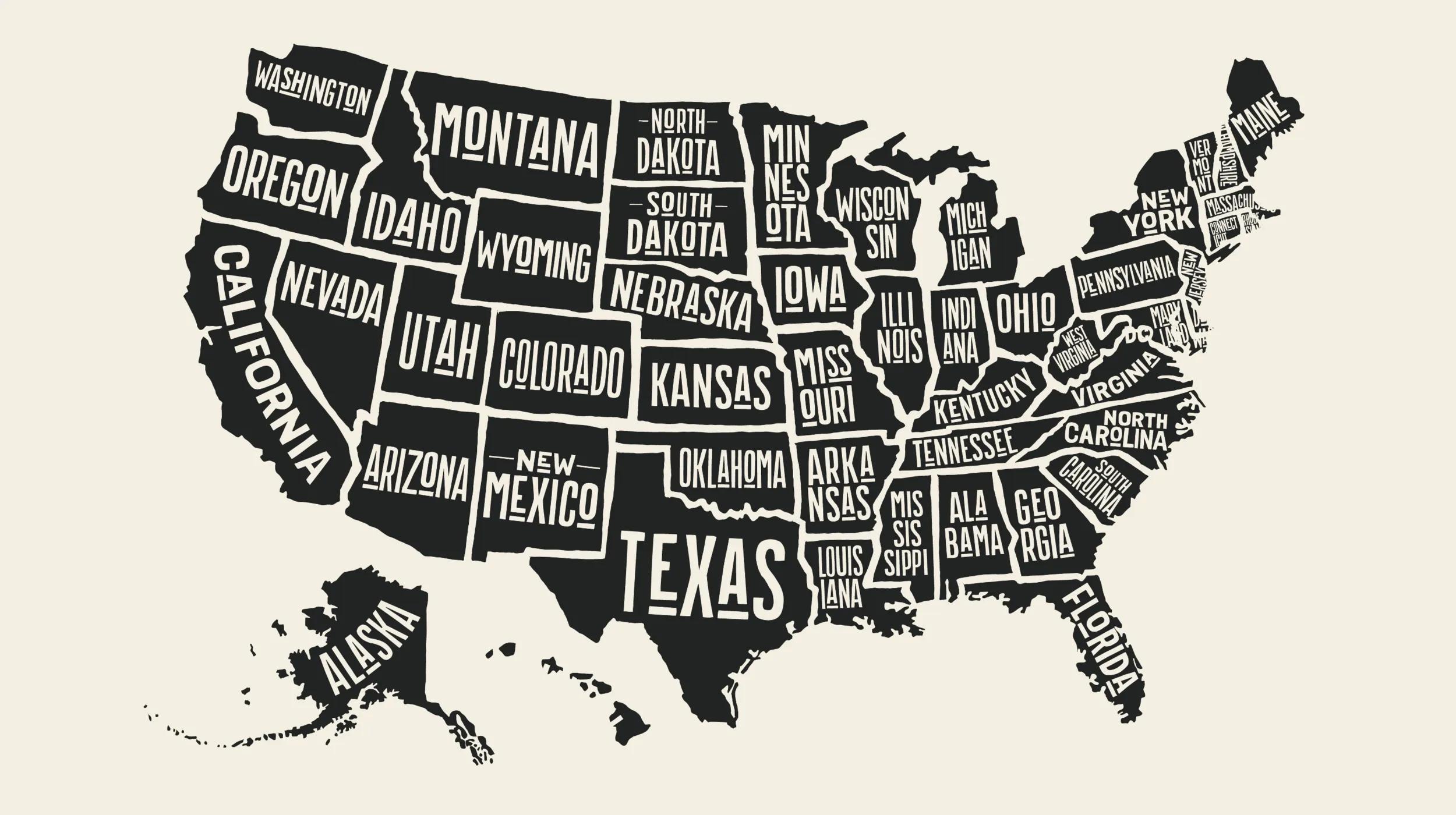Running a business today means finding ways to build a steady, reliable income. That’s why so many entrepreneurs are exploring the subscription business model.
Instead of chasing one-off transactions, this approach focuses on recurring revenue that builds month after month.
This strategy can give your business more stability, scalability, and customer loyalty. If you haven’t built a brand yet, subscription services can be a great way to start an online business.
Before deciding whether this is the right journey to embark on, let’s dive into what a subscription-based business model is, how it works, and subscription business ideas.
What is a subscription business model and how does it work?
A subscription business model is a method of selling products or services where customers pay a recurring fee — monthly, quarterly, or annually — for continued access. Unlike one-time purchase models, where a customer buys something once and the relationship often ends there, subscriptions are designed to keep people engaged and connected to your business over time.
This business model shifts the focus from individual transactions to long-term relationships. Customers commit to ongoing payments, and in return, they receive consistent value.

This creates recurring revenue that’s easier to predict for businesses, making it possible to plan growth and expenses more effectively. For customers, it offers convenience, reliability, and a sense of continuity.
The biggest difference between a one-time purchase and a subscription lies in momentum. A one-time purchase gives your business a short-term boost, while subscriptions create steady income streams that can scale as your customer base grows.
If you’re new to this concept, learn more about what is a business model here.
Related: Examples of startups
Benefits and key characteristics of subscription business models
A subscription-based business model is about creating a structure that supports long-term growth and customer loyalty. Here are the key features and benefits that make subscription models so effective.
Recurring revenue and predictability
Subscription services provide steady income streams you can count on month after month. Unlike one-time purchases, this approach allows you to forecast sales more accurately and plan for sustainable growth.
Customer relationship and retention
The foundation of any subscription business is building long-term customer relationships. When people subscribe, they’re committing to your brand, which creates more opportunities to build trust and reduce churn.
Value-based and tiered pricing
Many subscription businesses offer multiple pricing tiers, giving customers the flexibility to choose the level of service that fits them best. This is a value-based approach to pricing that helps you reach wider audiences without changing your core offering.
Scalability
Because subscription revenue is more reliable, businesses can scale with less risk. It also makes it easier to manage expenses, expand teams, or invest in new product lines.
Upselling and cross-selling opportunities
Subscriptions naturally create touchpoints where you can introduce add-ons or higher-value plans. This increases revenue potential while giving customers more tailored, helpful solutions.
Flexibility and customization
Customers want choices. A flexible subscription model, whether it’s skipping a month, swapping products, or customizing services, helps keep them engaged and satisfied.
Customer data insights
Because subscription models generate ongoing data, businesses can personalize offerings and create relevant, engaging experiences. This improves customer satisfaction and loyalty over time.
Benefits for businesses
For businesses, subscriptions mean stable cash flow, deeper customer insights, and a more strategic way to grow. This model supports both immediate goals and long-term success.
Benefits for customers
For customers, the value of subscription services lies in convenience, consistency, and access. They enjoy the peace of mind that comes with reliable services and products delivered on their terms.
Types of subscription-based businesses
The beauty of the subscription business model is that it can adapt to nearly any industry. Here are some of the most common subscription business ideas with examples, pros and cons, and who they’re best suited for.
Related: Online business ideas
Media and entertainment
From Netflix and Spotify to digital news subscriptions, the media and entertainment industries were early adopters of subscription models. Customers pay for access to a library of content like shows, music, podcasts, and premium articles. The key here is keeping audiences engaged with new content so they continue paying month after month.
Pros:
- Highly scalable
- Strong potential for customer loyalty
- Wide appeal across demographics and niches
Cons:
- High churn rates if content quality drops
- Intense competition with major players dominating the market
- Significant upfront costs for content creation or licensing
Best for: Content creators, publishers, and media brands that can deliver consistent value.
Software and technology (SaaS)
In software, the subscription model has become the standard. Instead of buying a program outright, customers pay monthly or annually for continued access. This covers everything from website hosting and ecommerce platforms to productivity tools and accounting software. For example, GoDaddy customer Kevin Abrams discovered recurring potential by offering website maintenance subscriptions to clients. Four of his six existing clients signed up immediately.
Pros:
- Low cost to scale once the product is developed
- Customer retention is strong when software becomes indispensable
Cons:
- Constant updates and improvements are expected
- Customer support must be ongoing and responsive
- Market saturation means businesses must stand out with features or services
Best for: Developers, IT providers, and tech-savvy individuals.
Retail and ecommerce
Ecommerce business ideas, like subscription boxes and auto-replenishment services, bring physical goods into the subscription space. Customers love the convenience of consumables or the surprise of curated products arriving at their door. GoDaddy customer Natasha Williams, for instance, built Natasha Nails, a monthly subscription service for hand-painted press-on nails. This gave her customers new styles every month while creating steady sales for her business.
Pros:
- Builds loyalty by delivering consistent or curated value
- Predictable inventory cycles
- Opportunity to create community through niche boxes or themes
Cons:
- Shipping and logistics can eat into profits
- Inventory management is complex and time-sensitive
- Churn risk is higher if products aren’t refreshed or unique enough
Best for: Individuals or businesses selling unique products.
Related: What is ecommerce?
Health and fitness
From gym memberships to meditation apps, health and fitness subscriptions thrive on the promise of habit and routine. Customers pay for access to workouts, training plans, or wellness services.
Pros:
- Builds strong customer engagement
- Opportunities to upsell add-ons like personal coaching or premium plans
- Large and diverse market
Cons:
- Potential for seasonal churn (e.g., New Year’s resolutions)
- Requires ongoing value, like new workouts or classes, to keep users engaged
- Competition is fierce, especially in the digital app space
Best for: Fitness coaches, gyms, wellness professionals, or health-focused startups.
Food and meal kits
Meal kit services and snack subscriptions appeal to busy customers who want variety and convenience. Subscribers receive pre-portioned meals, recipe kits, or curated snacks on a recurring basis.
Pros:
- Strong demand for convenient, time-saving solutions
- Repeat purchases make for reliable recurring revenue
- Opportunity for niche targeting (e.g., vegan kits, kid-friendly snacks)
Cons:
- Requires strict quality control and fast shipping
- Shipping costs and logistics are expensive
- Churn can spike if meals feel repetitive or prices rise
Best for: Food startups, chefs, and entrepreneurs looking to deliver unique, consumable experiences.
Home maintenance
Recurring services like lawn care, pest control, cleaning, or HVAC maintenance can also be built on subscription models. Customers appreciate the convenience of having ongoing needs handled without having to book each time.
Pros:
- Builds stable, long-term customer relationships
- Predictable cash flow makes staffing and scheduling easier
- Upsell potential for seasonal or specialized services
Cons:
- Labor management and scheduling can be complex
- Strong local competition may drive down prices
- Seasonal dips in demand for certain services
Best for: Local service providers who want stability and consistent income.
Education
Learning platforms and skill-building subscriptions are on the rise. Customers pay for access to courses, tutorials, or certification programs, which can be digital, on-demand, live, or in-person.
Pros:
- Global reach with low overhead once content is created
- High demand for reskilling and personal development
- Opportunity to build communities around shared learning
Cons:
- Requires ongoing updates to keep material relevant
- Competition is strong from free alternatives
- Churn can happen if learners don’t stay engaged
Best for: Educators, trainers, or subject matter experts.
How do you choose the right subscription model for your business?
Deciding which subscription business model fits your product or service requires studying your market and long-term goals. The best models succeed because they serve a clear customer need while supporting predictable revenue for the business. To choose the right subscription model before you start a business:
- Evaluate market demand: Is your product or service something people will use regularly or want access to on an ongoing basis? For example, consumables like coffee or pet supplies are naturally suited to product-based subscriptions, while digital tools fit perfectly into SaaS or service-based models.
- Assess product fit: If your offering requires constant updates (like software), a recurring digital service may be ideal. If customers benefit from variety or convenience, curated boxes or meal kits could be a better match. Not sure what product or service to offer? Check out these small business ideas for inspiration.
- Consider your business goals: Are you aiming for steady income you can scale slowly, or rapid growth with the potential for upselling? Think about how predictable you need your revenue to be, how much you’re prepared to invest in logistics or support, and how you plan to retain customers long term.
Here’s a simple checklist to guide your decision:
- Does my product or service solve a recurring need?
- Can I deliver consistent value over time?
- What type of subscription model matches my capacity (physical products, digital services, memberships)?
- Do I have a plan to engage and retain subscribers beyond the first month?
How to start a subscription-based business
Launching a subscription business requires clear planning, the right tools, and a customer-first mindset. Follow the four steps below to get started.
Step 1: Refine your idea and business plan
Start by identifying what recurring value you can deliver. Does your product solve an ongoing need, or does your service provide consistent support over time? Research your target market, outline your pricing model, and define how you’ll stand out from competitors. You can create a small business sales plan to give yourself a clear path forward.
Step 2: Build your online presence
Your business needs a home base. Setting up an ecommerce site or membership platform makes it simple for customers to sign up and stay engaged. If you’re selling products, learning how to start an online store is a great starting point. You can use GoDaddy’s tools to create an online store when you’re ready. For community-driven offerings, you may want to start a membership website instead.
Want help managing the technical aspects of your online presence? Check out GoDaddy’s hosting solutions.
Step 3: Set up subscriptions and payments
Next, integrate the tools that will power your recurring revenue. Choose a subscription plugin or ecommerce platform that allows for flexible tiers, customer management, and automated billing. You also need to decide how to accept payments. GoDaddy Payments makes it easy to accept payments in-person and online, so you never miss a sale.
Step 4: Launch and market your subscription
Once you’re all set up, it’s time to launch. Use email campaigns, social media, and partnerships to spread the word. Make onboarding simple for new subscribers and focus on building long-term relationships, not just sign-ups.
Pricing strategies for subscription businesses: How much should you charge?
One of the most important decisions you’ll make when launching a subscription-based business model is setting the right price. Charge too little, and profitability becomes a challenge. Charge too much, and you risk losing potential customers. The best approach is to use proven pricing strategies like the following that balance customer value with sustainable revenue.
- Tiered pricing: Offer multiple plans at different price points, each with its own set of features or benefits. This allows you to reach a wider audience while creating opportunities for upselling.
- Usage-based pricing: Customers pay based on how much they use the service, making this model ideal for businesses where demand can vary.
- Freemium model: Provide a free version with limited features to attract users, then encourage upgrades to premium tiers for full access. This works well for software and apps.
- Flat-rate pricing: A single recurring price keeps things simple and transparent. This is often used by subscription boxes or streaming platforms.
- Per-user or per-seat pricing: This model charges businesses or teams based on the number of users. It’s a popular choice for SaaS subscriptions.
Subscriber retention strategies: How to reduce churn
Acquiring new subscribers is important, but keeping them is what makes a subscription business model sustainable. Churn often happens when customers don’t see enough value, lose interest, or run into poor communication. The good news? With the right strategies, you can strengthen relationships and keep subscribers engaged.
- Streamline onboarding: Make the first experience seamless. Clear instructions, welcome messages, and early value delivery help set expectations.
- Personalize communication: Use customer data to tailor offers, recommendations, and reminders. Subscribers are more likely to stay if they feel seen and understood.
- Offer loyalty perks: Rewards programs, exclusive content, or discounts for long-term subscribers can help boost customer retention by offering extra value.
- Proactive support – Check in before problems escalate. Proactive outreach, surveys, or renewal reminders show customers you care about their experience.
Professional, branded communication makes a difference here. Whether you’re asking for feedback, sending updates, or thanking customers, using a professional business email from GoDaddy builds trust and reinforces your brand’s credibility.
Marketing strategies for subscription-based models
Growth depends on effective marketing for any subscription business model. Subscriptions require you to win customers over with your story, keep them engaged with your brand, and motivate them to stick around for the long term.
Focus on visibility first. Strong search engine optimization (SEO) and content marketing ideas help you attract customers who are actively searching for what you offer. Pair that with consistent social media engagement, where storytelling and behind-the-scenes content make your brand more relatable.
Referrals are another powerful tool. Encourage current subscribers to share your service with friends by offering discounts or perks for successful referrals. Partnerships, like collaborating with influencers or teaming up with complementary businesses, can also open new doors.
Community-building should always be at the center of your strategy. Storytelling that highlights your mission or values can create an emotional connection that drives loyalty. Just as importantly, listening to your audience matters. Incorporating customer feedback into your decisions can improve your offerings while showing subscribers their voices matter.
Regardless of your industry, marketing has many moving parts. Mapping out campaigns, content, and customer touchpoints in a clear marketing plan can help you stay on track.
Key KPIs to track to measure your subscription business’s health
Key performance indicators (KPIs) are measurable benchmarks that track how well your business is performing. They highlight where you’re succeeding, reveal areas that need improvement, and provide data you can use to adjust pricing, marketing, or retention strategies. Without them, it’s easy to lose sight of long-term health and focus only on short-term wins.
Every business focuses on a slightly different set of KPIs, but the ones listed below are critical for subscription-based businesses.
- Monthly Recurring Revenue (MRR): The backbone of any subscription business, MRR shows predictable income each month. Use it to forecast growth and budget effectively.
- Churn rate: The percentage of customers who cancel their subscriptions. A high churn rate signals issues with retention, value delivery, or customer experience.
- Customer Lifetime Value (CLTV): Measures the total revenue you can expect from one subscriber. The higher your CLTV, the more sustainable your growth becomes.
- Customer Acquisition Cost (CAC): Tracks how much it costs to win a new subscriber. Compare CAC against CLTV to make sure you’re acquiring customers profitably.
- Average Revenue Per User (ARPU): Shows how much revenue each subscriber generates on average. Use it to spot upsell opportunities and refine pricing.
Want to explore more KPI options? Read this detailed guide to KPIs.
Launch your subscription business with GoDaddy
The subscription business model has become one of the most reliable ways to build steady revenue, foster loyal customers, and scale sustainably. From choosing the right subscription type to setting pricing, tracking KPIs, and refining retention strategies, success comes from building a model that balances customer value with predictable growth.
With GoDaddy Airo, you can bring your subscription idea to life faster. Airo helps you design your brand, create marketing content, and build a professional online presence so you can focus on delivering value to your subscribers. Get started today!
FAQs about subscription-based business models
How much does it cost to start a subscription business?
Startup costs depend on the type of subscription business you’re launching. A product-based business will need inventory, packaging, and shipping, while digital or service-based models mainly require a website, payment processing, and marketing. Many entrepreneurs start small and then scale as revenue grows.
Is a subscription model profitable?
Yes, subscription business models can be very profitable when managed well. The recurring revenue provides predictable cash flow, which makes it easier to budget and scale. Profitability depends on setting the right pricing, keeping acquisition costs lower than customer lifetime value, and focusing on retention to reduce churn.
Why do subscription models fail?
Most subscription model failures come down to three issues: poor product-market fit, weak customer retention, or pricing that doesn’t balance value with sustainability. Subscriptions succeed when they solve a recurring need, deliver consistent value, and engage customers long-term. Neglecting those areas often leads to churn and stalled growth.
How do I handle failed payments or billing issues?
To handle failed payments or billing issues, use automated billing systems that retry failed charges and notify customers quickly. Offering multiple payment options can also reduce issues. It’s important to keep communication professional and proactive; reminders, updates, and a clear process for resolving billing problems help maintain trust and minimize cancellations.
What are the alternatives to subscription models?
Alternatives to subscription models include one-time purchase models, pay-per-use or transaction-based pricing, and hybrid approaches that blend subscriptions with add-ons or upsells. The best business model is the one that fits your product or service and audience preferences.







